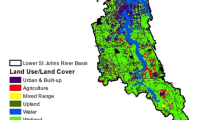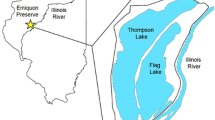Abstract
In the United States, the Clean Water Act requires mitigation for wetlands that are negatively impacted by dredging and filling activities. During the mitigation process, there generally is little effort to assess function for mitigation sites and function is usually inferred based on vegetative cover and acreage. In our study, hydrogeomorphic (HGM) functional assessment models were used to compare predicted and potential levels of functional capacity in created and natural reference wetlands. HGM models assess potential function by measurement of a suite of structural variables and these modeled functions can then be compared to those in natural, reference wetlands. The created wetlands were built in a floodplain setting of a valley in central Pennsylvania to replace natural ridge-side slope wetlands. Functional assessment models indicated that the created sites differed significantly from natural wetlands that represented the impacted sites for seven of the ten functions assessed. This was expected because the created wetlands were located in a different geomorphic setting than the impacted sites, which would affect the type and degree of functions that occur. However, functional differences were still observed when the created sites were compared with a second set of reference wetlands that were located in a similar geomorphic setting (floodplain). Most of the differences observed in both comparisons were related to unnatural hydrologic regimes and to the characteristics of the surrounding landscape. As a result, the created wetlands are not fulfilling the criteria for successful wetland mitigation.



Similar content being viewed by others
References
A.D. Marble and Company (2000) Water Budget Analysis: S.R. 0220, Section E10 wetland creation sites, Bald Eagle Valley, Centre and Blair counties, Pennsylvania. Pennsylvania Department of Transportation, Rosemont, Pennsylvania
Atkinson RB, Cairns J Jr (2001) Plant decomposition and litter accumulation in depressional wetlands: Functional performance of two wetland age classes that were created via excavation. Wetlands 21:354–362
Atkinson JB Perry JE, Cairns J Jr (2005) Vegetation communities of 20-year-old created depressional wetlands. Wetland Ecology and Management 13:469–478
Bedford BL (1996) The need to define hydrologic equivalence at the landscape scale for freshwater wetland mitigation. Ecological Applications 6:57–68
Bedford BL, Preston EM (1988) Developing the scientific basis for assessing cumulative effects of wetland loss and degradation on landscape functions: Status, perspectives and prospects. Environmental Management 12:751–771
Bishel-Machung L, Brooks RP, Yates SS, Hoover KL (1996) Soil properties of reference wetlands and wetland creation projects in Pennsylvania. Wetlands 16:532–541
Brinson MM (1993) A hydrogeomorphic classification for wetlands. Army Corps of Engineers Wetlands Research Program Technical Report WRP-DE-4, Vicksburg, MS
Brooks RP, Prosser DJ (1995) Wildlife Habitat Suitability Models. CWC Report 95-1, Penn State Cooperative Wetlands Center, University Park, PA
Brooks RP, Wardrop DH, Bishop JA (2002) Watershed-based protection for wetlands in Pennsylvania: Levels 1&2: Synoptic maps and rapid field assessments. Final Report to Pennsylvania Department of Environmental ProtectionPenn State Cooperative Wetlands Center, Pennsylvania State University, University Park, PA
Brooks RP, Rubbo JM, Wardrop DH, Mahaney WM, Cole CA (2004a) Hydrogeomorphic functional assessment models by wetland type for Pennsylvania ecoregions. Part II.b.3.b.4. In: Brooks RP (ed). Monitoring and Assessing Pennsylvania Wetlands. Final Report for Cooperative Agreement NoX-827157-01, between Penn State Cooperative Wetlands Center, Pennsylvania State University, University Park, PA and U.S. Environmental Protection Agency, Office of Wetlands, Oceans, and Watersheds, Washington, DC
Brooks RP, Wardrop DH, Rubbo JM, Mahaney WM, Cole CA (2004b) Hydrogeomorphic Variables. Part II.b.3.b.3. In: Monitoring and Assessing Pennsylvania Wetlands. Final Report for Cooperative Agreement NoX-827157-01, between Penn State Cooperative Wetlands Center, Pennsylvania State University, University Park, PA and U.S. Environmental Protection Agency, Office of Wetlands, Oceans, and Watersheds, Washington, DC
Brown SC, Veneman PLM (2001) Effectiveness of compensatory wetland mitigation in Massachusetts, USA. Wetlands 21:508–518
Campbell DA, Cole CA, Brooks RP (2002) A comparison of created and natural wetlands in Pennsylvania, USA, Wetlands Ecology and Management 10:41–49
Cole CA (2002) The assessment of herbaceous plant cover in wetlands as an indicator of function. Ecological Indicators 56:1–7
Cole CA, Brooks RP (2000a) A comparison of the hydrologic characteristics of natural and created mainstem floodplain wetlands in Pennsylvania. Ecological Engineering 14:221–231
Cole CA, Brooks RP (2000b) Patterns of wetland hydrology in the ridge and valley province, Pennsylvania, USA. Wetlands 20:438–447
Cole CA, Shafer D (2002) Section 404 wetland mitigation and permit success criteria in Pennsylvania, USA, 1986–1999. Environmental Management 30:508–515
Cole CA, Brooks RP, Wardrop DH (1997) Wetland hydrology as a function of hydrogeomorphic (HGM) subclass. Wetlands 17:456–467
Cole CA, Brooks RP, Wardrop DH (2001) Assessing the relationship between biomass and soil organic matter in created wetlands of central Pennsylvania, USA. Ecological Engineering 17:423–428
Confer SR, Niering WA (1992) Comparison of created and natural freshwater emergent wetlands in Connecticut (USA). Wetlands Ecology and Management 2:143–156
Dahl TE (2000) Status and trends of wetlands in the conterminous United States, 1986 to 1997. U.S. Department of the Interior, Fish and Wildlife Service, Washington, DC
Ehrenfeld JG, Schneider JP (1993) Responses of forested wetland vegetation to perturbations of water chemistry and hydrology. Wetlands 13:122–129
Fennessey S, Roehrs J (1997) A functional assessment of mitigation wetlands in Ohio: Comparisons with natural systems. Ohio Environmental Protection Agency, Columbus, OH
Gibson DJ (1989) Effects of animal disturbance on tall-grass prairie vegetation. American Midland Naturalist 121:144–154
Gilliam FS, May JD, Fisher MA, Evans DK (1999) Short-term changes in soil nutrients during wetland creation. Wetlands Ecology and Management 6:203–208
Gleason HA, Cronquist A (1991) Manual of vascular plants of Northeastern United States and adjacent Canada, 2nd edition. The New York Botanical Garden, Bronx, NY
Gwin SE, Kentula ME, Shaffer PW (1999) Evaluating the effects of wetland regulation through hydrogeomorphic classification and landscape profiles. Wetlands 19:477–489
Hammer DA (1993) Creating freshwater wetlands, Lewis Publishers, Inc, Chelsea, MI
Hemond HF, Benoit J (1988) Cumulative impacts on water quality functions of wetlands. Environmental Management 12:639–53
Higgins JJ (2004) Introduction to modern non-parametric statistics, Brooks/Cole-Thomson Learning, Pacific Grove, CA
Hoeltje SM (2005) Functional assessment of created and natural wetlands in central Pennsylvania. MS thesis, Ecology Program, The Pennsylvania State University, University Park, PA
Holmgren NH (1998) The illustrated companion to Gleason and Cronquist’s manual: Illustrations of the vascular plants of Northeastern United States and adjacent Canada. The New York Botanical Garden, Bronx, NY
Jarman NM, Dobberteen RA, Windmiller B, Lelito PR (1991) Evaluation of created freshwater wetlands in Massachusetts. Restoration and Management Notes 9:26–29
Jules ES (1998) Habitat fragmentation and demographic change for a common plant: Trillium in old-growth forest. Ecology 79:1645–1656
Leibowitz SG, Abbruzzese B, Adamus PR, Hughes LE, Irish JT (1992) A synoptic approach to cumulative impacts assessment. A proposed methodology U.S. EPA, EPA/600/R-92/167, Corvallis, OR. 129 pp
McCollin D, Moore L, Sparks T (2000) The flora of a cultural landscape: environmental determinants of change revealed using archival sources. Biological Conservation 92:249–263
National Research Council (2001) Compensating for Wetland Losses Under the Clean Water Act. National Academy Press, Washington DC
Rhoads AF, Block TA (2000) The plants of Pennsylvania: An illustrated manual. University of Pennsylvania Press, Philadelphia, PA
Ripple KL, Garbisch EW (2000) POW! The planning of wetlands. Environmental Concern, Inc., St. Michaels, MD
Risser PG (1988) General concepts for measuring cumulative impacts on wetland ecosystems. Environmental Management 12:585–589
Robinson GR, Holt RD, Gaines MS, Hamburg SP, Johnson ML, Fitch HS, Martinko EA (1992) Diverse and contrasting effects of habitat fragmentation. Science 257:524–526
Shaffer PW, Ernst TL (1999) Distribution of soil organic matter in freshwater emergent/open water wetlands in the Portland Oregon metropolitan area. Wetlands 19:505–516
Shaffer PW, Kentula ME, Gwin SE (1999) Characterization of wetland hydrology using hydrogeomorphic classification. Wetlands 19:490–504
Smith RD, Ammann A, Bartoldus C, Brinson MM (1995) An approach for assessing wetland function using hydrogeomorphic classification, reference wetlands, and functional indices. Wetlands Research Technical Report WRP-DE-9, US Army Corps of Engineers, Washington, DC
Stolt MH, Genthner MH, Daniels WL, Groover VA, Nagle S, Haering KC (2000) Comparison of soil and other environmental conditions in constructed and adjacent palustrine reference wetlands. Wetlands 20:671–683
U.S. EPA (1990) Memorandum of agreement between the Environmental Protection Agency and the Department of the Army concerning the determination of mitigation under the Clean Water Act Section 404(b) (1) Guidelines. U.S. EPA, Washington, DC
USDA NRCS (2004) The PLANTS Database, Version 3.5 (http://www.plants.usda.gov ), National Plant Data Center, Baton Rouge, LA
Wardrop DH, Brooks RP (1998) The occurrence and impact of sedimentation in central Pennsylvania wetlands. Environmental Monitoring and Assessment 51:119–130
Wardrop DH, Brooks RP, Bishel-Machung L, Cole CA, Rubbo JM (2004) Wetland sampling protocol in support of hydrogeomorphic (HGM) functional assessment. Part II.b.3.a. In: Brooks RP (ed). Monitoring and Assessing Pennsylvania Wetlands. Final Report for Cooperative Agreement NoX-827157, between Penn State Cooperative Wetlands Center, Pennsylvania State University, University Park, PA and U.S Environmental Protection Agency, Office of Wetlands, Oceans, and Watersheds, Washington, DC
Whigham DF, Chitterling C, Palmer B (1988) Impacts of freshwater wetlands on water quality: A landscape perspective. Environmental Management 12:663–671
Zedler JB, (1996) Ecological issues in wetland mitigation: An introduction to the forum. Ecological Applications 6:33–37
Acknowledgments
Funding for this project was provided by a STAR grant from the U.S. Environmental Protection Agency (R-82949701-0). We thank D. Wardrop, G. Peterson, and L. Kump for their insights and advice throughout this project. We also thank the following people who provided data and other assistance: J. Rubbo, S. Miller, N. Kraus, and J. Bishop of the Penn State Cooperative Wetlands Center. The U. S. Army Corps of Engineers, State College Field Office, and Skelly and Loy, Inc., provided permitting and site-specific information on the created and impacted wetlands. Thanks also to P. Ryan, S. Torgerson, B. Dietz, R. Orndorff, and Z. Hough for assistance in the field. We especially thank J. Peterson for extensive field help, advice, and comments.
Author information
Authors and Affiliations
Corresponding author
Rights and permissions
About this article
Cite this article
Hoeltje, S.M., Cole, C.A. Losing Function Through Wetland Mitigation in Central Pennsylvania, USA. Environmental Management 39, 385–402 (2007). https://doi.org/10.1007/s00267-006-0212-z
Received:
Accepted:
Published:
Issue Date:
DOI: https://doi.org/10.1007/s00267-006-0212-z




